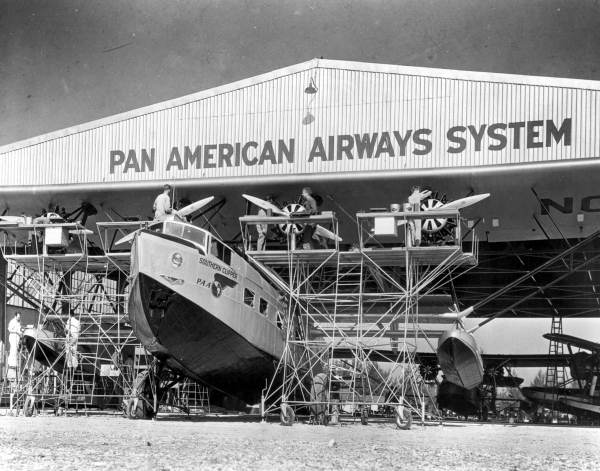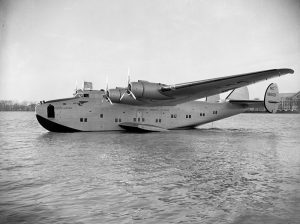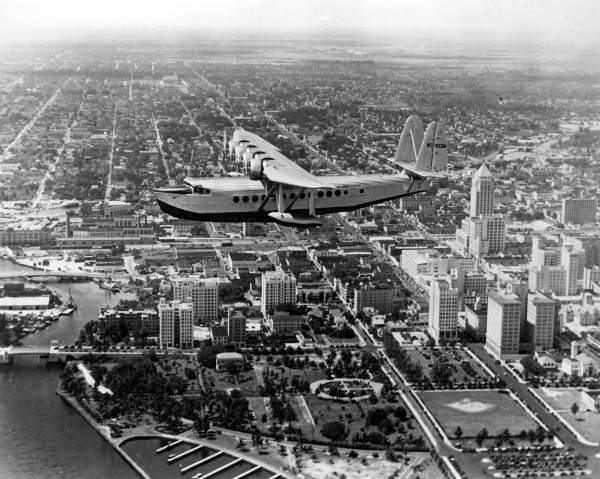The Long Way Home….Pan Am Flight 18602 – June 9, 2024
The Airlines – The Pilots – The Unions – May 31, 2024
May 31, 2024
“Upside Down” Pangborn…..First to Fly the Pacific Nonstop – June 14, 2024
June 14, 2024RN3DB
June 9, 2024
Good Morning,
The D-Day/Normandy Invasion occurred eighty years ago on June 6, 1944, and I was once again reminded of the bravery of the landing forces hitting the beach, dropping in by air, and landing in Gliders. The number of US, and allied, Forces who died that day was estimated to be 4500 and another 5000 wounded or missing. When we talk missing what we are talking about are bodies that were washed out to sea, and bodies in destroyed gliders, and other aircraft, that could not be identified in the ashes. An amazing feat made possible by the amazing courage for those who led the way to victory.
Now, on with the story of Pan Am flight 18602 and how Pan Am responded to the attack on Pearl Harbor…..
Pan Am Flight 18602
Bill Gates made a very interesting observation while giving a speech at a public event which I would like to share with you now. “The Wright Brothers created the single greatest cultural force since the invention of writing. The airplane became the first World Wide Web, bringing people, languages, ideas, and values together.” Interesting observation, and one that I agree with, but I would have also added that Pan American Airways took the World Wide Web, as noted by Bill Gates, to that level and made it all work.
Today, we will talk about how Pan Am did that, but first I want to talk about Pan Am and flight 18602. I hope you find this as interesting as I do and at the conclusion of the main article I have a brief overview of Pan Am and their Clipper fleet followed by an outstanding video. However before we proceed let me set the stage with the following:
On December 7, 1941, when the Japanese attacked Pearl Harbor, there was a Pan Am Clipper proceeding to Auckland, New Zealand when the radio operator announced to the crew, in a panicked voice, that Pearl Harbor had been attacked. The Captain realized that this was not a joke, after looking over at the radio operator’s face, and said, “Please confirm the details of your news with Pan Am headquarters in New Caledonia.”
When the radio operator returned to the Captain’s side he advised that the news was in fact correct and they advised me to tell you the following, “Implement Plan A.” The Captain reached for a sealed envelope from his jacket and read the following words:
From: Division Manager, Pacific Division
Subject: Special instructions to avoid hostile military activity.
Pan American Airways, in cooperation with the Chief of Staff, United States Army, Commander-in-Chief, Pacific Fleet Operations, the Secretary of War and the Secretary of State, has agreed to place its fleet of flying boats at the disposal of the military for whatever logistical or tactical purpose they may deem necessary at such time as hostilities break out between the United States forces and the military forces of the Imperial Japanese government.
In the event that you are required to open and read these instructions, you may assume that hostilities have already occurred and that the aircraft under your command represents a strategic military resource which must be protected and secured from falling into enemy hands
Now, lets talk about what happened next……..Enjoy.
The First Around-the-World Commercial Flight
Stranded. Six days from its home port of San Francisco, a luxurious Boeing 314 flying boat, the Pacific Clipper, was preparing to alight in Auckland, New Zealand, as part of the airline’s transpacific service when the crew of ten learned of the Japanese attack on the U.S. fleet at Pearl Harbor on the morning of December 7, 1941. All across the Pacific, Pan Am facilities came under assault: Wake Island, where the Martin M-130 Philippine Clipper returned just in time to pick up the Pan Am staff and escape although riddled with bullet holes; Manila, which had come under direct air attack; Hong Kong, where a Sikorsky S-42B was destroyed at its dock; and, of course, Pearl Harbor. Where to go?
Pan Am Captain Robert Ford was faced with a dilemma. After a week in the U.S. Embassy Ford finally received word from Pan Am headquarters that they were to return to the U.S. by flying westward. They were on their own for gasoline and supplies and had to fly over land and water with which none of the crew was familiar. With orders in hand, Captain Ford took off on December 16th, unsure of his fate, backtracked to Noumea, New Caledonia, to pick up the Pan Am staff left there and headed west for Australia. Hours later, they put down in Gladstone, north of Brisbane on the Coral Sea. The next day, Captain Ford and the Pacific Clipper headed northwest to Darwin, flying over the Queensland desert and watching it gradually transform into tropical rain forest near their destination of Darwin. The next goal was Surabaya, in the Dutch East Indies (present day Indonesia). Keeping their fingers crossed that the Japanese expansion had not reached this far, the crew of the massive flying boat flew 2,253 kilometers (1,400 miles) over open ocean and reached the city but not before they were intercepted by suspicious British fighter aircraft and escorted in to safety after taxiing through mined waters.
After refueling with automobile grade gasoline, since no 100 octane fuel was available, the Pacific Clipper carefully took off and headed for Trincomalee, Ceylon (now Sri Lanka) without any charts, only the coordinates of their destination. With remarkable precision, navigator Roderick Brown found the island and the port city where they alighted safely, although only after avoiding a patrolling Japanese submarine. Refueling once again, the Boeing 314 left Trincomalee on Christmas Eve only to turn back after losing an engine. Repairs took all day on Christmas before they retook to the air on Boxing Day bound for Karachi, India (now Pakistan). After an uneventful flight, Captain Ford continued safely on to Bahrain and then across the vast desert expanse of the Arabian peninsula to Khartoum, Sudan, where they alighted on the Nile. Not wishing to risk any further desert flying, the crew of the Pacific Clipper pressed on to Leopoldville in the Belgian Congo (now Kinshasa in the Democratic Republic of the Congo) and was able to put the huge flying boat down on the Congo River when they reached their destination.
Fighting the oppressive heat and the strong current of the river, the flying boat once again clawed into the sky becoming airborne before reaching a set of waterfalls. Safely clear of the obstacles, the Pacific Clipper droned 5,766 kilometers (3,583 miles) westward to Natal, Brazil, then up the coast to Port of Spain, Trinidad, and finally on January 6, 1942, to the Marine terminal at Laguardia, Long Island, New York. Total flight time was 209 hours which covered 50,694 kilometers (31,500 miles). It was the first around the world flight by a commercial airliner — the hard way.
After this historic flight, the Pacific Clipper was assigned to the U.S. Navy for the rest of World War II. When the War ended, the aircraft was sold to Universal Airlines who salvaged it after it was damaged in a storm.
The Clippers of Pan Am
The history of Pan American Airways is inextricably linked to the expansive vision and singular effort of one man – Juan Trippe. An avid flying enthusiast and pilot Trippe, only 28 years old when he founded the airline, lined up wealthy investors and powerful government officials from his personal acquaintances in the high-society of the 1920s. However, Pan Am’s first flight was an inauspicious start to its epic saga.
In 1927, facing a Post Office deadline for the commencement of mail carriage, Pan Am had no working equipment for its sole airmail contract between Key West and Havana. Fortunately for Pan Am, a pilot with his Fairchild seaplane arrived at Key West and was willing to carry the mail to Cuba for the start up operation.
Pan Am’s fortunes took a turn for the better in the fall of 1927. Through the heavy lobbying efforts of Juan Trippe, Pan Am was selected by the United States government to be its “chosen instrument” for overseas operations. Pan Am would enjoy a near monopoly on international routes. Pan Am added lines serving Mexico, Central America, the Dominican Republic and Haiti. Most of these destinations were port cities, which could be reached only by landing on water so Pan Am made good use of its “flying boats,” the Sikorsky S-38 and S-40. Flights were eventually expanded to serve much of South America.
Just a few years later, Pan Am launched its effort to cross the world’s largest oceans. Survey flights across the Pacific were conducted with the Sikorsky S-42 in 1935, but passenger service required bigger and better aircraft. Accompanied by much fanfare, the Martin M-130 was introduced in 1936, followed by the Boeing 314 in 1939. Known as Pan Am Clippers, these mammoth flying boats flew from San Francisco harbor skipping across the Pacific with stops at Hawaii, Midway Island, Wake Island, Guam, the Philippines and then Hong Kong. Advance teams had prepared the stopover islands by blasting coral to make safe coves for sea landings and constructing luxury hotels for Pan Am’s discerning, rich clientele. Next on the Pan Am list for conquest was the world’s other major ocean – the Atlantic.The Boeing 314 entered European service in 1939 flying from New York to Lisbon and Marseille by way of the Azores.
Boeing 314
As airplane travel became popular during the mid-1930s, passengers wanted to fly across the ocean, so Pan American Airlines asked for a long-range, four-engine flying boat. In response, Boeing developed the Model 314, nicknamed the “Clipper” after the great oceangoing sailing ships.
The Clipper used the wings and engine nacelles of the giant Boeing XB-15 bomber on the flying boat’s towering, whale-shaped body. The installation of new Wright 1,500 horsepower Double Cyclone engines eliminated the lack of power that handicapped the XB-15. With a nose similar to that of the modern 747, the Clipper was the “jumbo” airplane of its time.
The Model 314 had a 3,500-mile range and made the first scheduled trans-Atlantic flight June 28, 1939. By the year’s end, Clippers were routinely flying across the Pacific. Clipper passengers looked down at the sea from large windows and enjoyed the comforts of dressing rooms, a dining salon that could be turned into a lounge, and a bridal suite. The Clipper’s 74 seats converted into 40 bunks for overnight travelers. Four-star hotels catered gourmet meals served from its galley.
Boeing built 12 Model 314s between 1938 and 1941. At the outbreak of World War II, the Clipper was drafted into service to ferry materials and personnel. Few other aircraft of the day could meet the wartime distance and load requirements. President Franklin D. Roosevelt traveled by Boeing Clipper to meet with Winston Churchill at the Casablanca conference in 1943. On the way home, President Roosevelt celebrated his birthday in the flying boat’s dining room.
Sikorsky S-42
The Sikorsky S-40 had laid the groundwork for Pan Am’s Latin American route system, but Pan Am was never fully satisfied with its compromise design,. Even before the S-40 first entered service, Pan Am technical adviser Charles Lindbergh was developing specifications for a streamlined airliner that could truly span the oceans and fulfill Pan Am’s intercontinental ambitions.
Two aircraft manufacturers made credible bids for Pan American’s next airliner. Igor Sikorsky wanted the chance to build improve the S-40, whose limitations he fully understood, and Glenn Martin wanted to expand his business from military to commercial aircraft. To hedge his bets against either company’s possible failure, and to stimulate competition, so that Pan Am would not be overly dependent on any one firm, Juan Trippe accepted both bids and ordered three planes from each company. On October 1, 1932, Pan Am placed a firm order for three S-42 aircraft, with an option for seven additional planes.
Martin M-130
Even before the first Sikorsky S-40 entered service in 1931, it was obvious that the plane — which Charles Lindbergh called a flying forest — would not provide the performance necessary to fulfill Pan Am’s ambitions. Consequently, the airline began searching a streamlined airliner that could truly span the oceans. Two manufacturers wanted the job. Igor Sikorsky wanted a chance to improve on his own S-40, and Glenn Martin wanted to establish his company in the commercial aviation business. Juan Trippe ordered planes from both.
The driving force behind Pan Am’s specifications for a new plane was Andre Priester, the Dutch immigrant who had worked for KLM and who became Pan Am’s detail-obsessed chief engineer. Charles Lindbergh, who had been so deeply involved with Pan Am’s earlier designs, had just undergone the trauma of his son’s kidnapping and murder on March 1, 1932, and was only minimally involved with the plans for the new clipper.
Pan Am wanted a plane that could fly 3,000 miles (long enough to reach Europe or Hawaii) while carrying a payload equal to its own weight, and the Glenn L. Martin Aircraft Company designed a plane that met the airline’s needs. Although the first Martin M-130 was delivered over a year behind schedule, and its $417,200 cost was almost twice that of the Sikorsky S-42 (and more than five times the $78,000 price of the leading airliner of the day, the Douglas DC-2), the M-130 had the speed, size, and range to carry mail and passengers profitably across the Pacific or Atlantic.
The first M-130, named China Clipper, was delivered to Pan American on October 9, 1935, just two days after its first test flight. A little more than a month later, on November 22, 1935, China Clipper left San Francisco on the first scheduled mail flight across the Pacific ocean.
Enjoy time with family and friends, enjoy the video below, and have a good weekend.
Robert Novell
June 9, 2024




